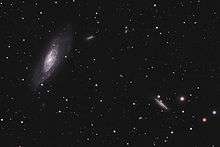Messier 106
| Messier 106 | |
|---|---|
 M 106 and its anomalous arms. Composite of IR (red) and optical light (Image credit: NASA, ESA, the Hubble Heritage Team (STScI/AURA), and R. Gendler (for the Hubble Heritage Team)) | |
| Observation data (J2000 epoch) | |
| Constellation | Canes Venatici |
| Right ascension | 12h 18m 57.5s[1] |
| Declination | +47° 18′ 14″[1] |
| Redshift | 448 ± 3 km/s[1] |
| Distance | 23.7 ± 1.5 Mly (7 ± 0.5 Mpc)[2][3] |
| Apparent magnitude (V) | 9.1[1] |
| Characteristics | |
| Type | SAB(s)bc[1] |
| Size | 135,000 ly (in diameter)[4] |
| Apparent size (V) | 18′.6 × 7′.2[1] |
| Notable features | Maser galaxy,[5] Seyfert II galaxy.[6] |
| Other designations | |
| M 106, NGC 4258, UGC 7353, PGC 39600.[1][7] | |


Messier 106 (also known as NGC 4258) is an intermediate spiral galaxy in the constellation Canes Venatici. It was discovered by Pierre Méchain in 1781. M106 is at a distance of about 22 to 25 million light-years away from Earth. It is also a Seyfert II galaxy. Due to x-rays and unusual emission lines detected, it is suspected that part of the galaxy is falling into a supermassive black hole in the center.[8] NGC 4217 is a possible companion galaxy of Messier 106.[7] A Type II supernova was observed in this galaxy in May 2014.[9]
Characteristics
M106 has a water vapor megamaser (the equivalent of a laser operating in microwave instead of visible light and on a galactic scale) that is seen by the 22-GHz line of ortho-H2O that evidences dense and warm molecular gas. These water vapors give M106 its characteristic purple color.[10] Water masers are useful to observe nuclear accretion disks in active galaxies. The water masers in M106 enabled the first case of a direct measurement of the distance to a galaxy and thereby providing an independent anchor for the cosmic distance ladder.[11][12] M106 has a slightly warped, thin, almost edge-on Keplerian disc which is on a subparsec scale. It surrounds a central area with mass 4 × 107M⊙.[13]
It is one of the largest and brightest nearby galaxies, similar in size and luminosity to the Andromeda Galaxy.[14]
M106 has also played an important role in calibrating the cosmic distance ladder. Before, Cepheid variables from other galaxies cannot be used to measure distances since they cover ranges of metallicities different from the Milky Way's. M106 contains Cepheid variables similar to both of the metallicities of the Milky Way and other galaxies' Cepheids. By measuring the distance of the Cepheids with metallicities similar to our galaxy, astronomers are able to recalibrate the other Cepheids with different metallicities, a key fundamental step in improving the distances to other galaxies in the universe.[3]
See also
References
- 1 2 3 4 5 6 7 "NASA/IPAC Extragalactic Database". Results for Messier 106. Retrieved 2006-12-07.
- ↑ Tonry, J. L.; et al. (2001). "The SBF Survey of Galaxy Distances. IV. SBF Magnitudes, Colors, and Distances". Astrophysical Journal. 546 (2): 681–693. arXiv:astro-ph/0011223
 . Bibcode:2001ApJ...546..681T. doi:10.1086/318301.
. Bibcode:2001ApJ...546..681T. doi:10.1086/318301. - 1 2 Macri, L. M.; et al. (2006). "A New Cepheid Distance to the Maser-Host Galaxy NGC 4258 and Its Implications for the Hubble Constant". Astrophysical Journal. 652 (2): 1133–1149. arXiv:astro-ph/0608211
 . Bibcode:2006ApJ...652.1133M. doi:10.1086/508530.
. Bibcode:2006ApJ...652.1133M. doi:10.1086/508530. - ↑ http://freestarcharts.com/index.php/20-guides/messier/262-messier-106-m106-spiral-galaxy freestarcharts
- ↑ Bonanos, Alceste Z. (2006). "Eclipsing Binaries: Tools for Calibrating the Extragalactic Distance Scale". Proceedings of the International Astronomical Union. 2 (S240). arXiv:astro-ph/0610923
 . Bibcode:2007IAUS..240...79B. doi:10.1017/S1743921307003845.
. Bibcode:2007IAUS..240...79B. doi:10.1017/S1743921307003845. - ↑ Humphreys, E. M. L.; et al. (2004). "Improved Maser Distance to NGC 4258". Bulletin of the American Astronomical Society. 36: 1468. Bibcode:2004AAS...205.7301H.
- 1 2 "SIMBAD Astronomical Object Database". Results for Messier 106. Retrieved 2006-12-07.
- ↑ Nemiroff, R.; Bonnell, J., eds. (15 February 2000). "A spiral galaxy with a strange core". Astronomy Picture of the Day. NASA.
- ↑ "KAIT Prediscovery Detection of PS1-14xz in NGC 4258 (Messier 106)". The Astronomer's Telegram. Retrieved 17 August 2015.
- ↑ Color analysis of M106: http://www.bt-images.net/incredible-universe/
- ↑ JR Herrnstein; et al. (1999). "A geometric distance to the galaxy NGC 4258 from orbital motions in a nuclear gas disk". Nature. 400: 539–541. arXiv:astro-ph/9907013
 . Bibcode:1999Natur.400..539H. doi:10.1038/22972.
. Bibcode:1999Natur.400..539H. doi:10.1038/22972. - ↑ Richard de Grijs (2011). An Introduction to Distance Measurement in Astronomy. Chichester: John Wiley & Sons. p. 109. ISBN 978-0-470-51180-0.
- ↑ Henkel, C.; et al. (2005). "New H2O masers in Seyfert and FIR bright galaxies". Astronomy and Astrophysics. 436 (1): 75–90. arXiv:astro-ph/0503070
 . Bibcode:2005A&A...436...75H. doi:10.1051/0004-6361:20042175.
. Bibcode:2005A&A...436...75H. doi:10.1051/0004-6361:20042175. - ↑ Karachentsev, Igor D.; Karachentseva, Valentina E.; Huchtmeier, Walter K.; Makarov, Dmitry I. (2003). "A Catalog of Neighboring Galaxies". The Astronomical Journal. 127 (4): 2031–2068. Bibcode:2004AJ....127.2031K. doi:10.1086/382905.
External links
| Wikimedia Commons has media related to Messier 106. |
- StarDate: M106 Fact Sheet
- Spiral Galaxy M106 at SEDS Messier pages
- Messier 106 on WikiSky: DSS2, SDSS, GALEX, IRAS, Hydrogen α, X-Ray, Astrophoto, Sky Map, Articles and images
- NGC 4258: Mysterious Arms Revealed
- Spiral Galaxy Messier 106 (NGC 4258) at the astro-photography site of Takayuki Yoshida
- Nemiroff, R.; Bonnell, J., eds. (19 March 2011). "Messier 106". Astronomy Picture of the Day. NASA.
- Nemiroff, R.; Bonnell, J., eds. (3 May 2012). "Messier 106". Astronomy Picture of the Day. NASA.
- Messier 106 at Constellation Guide
Coordinates: ![]() 12h 18m 57.5s, +47° 18′ 14″
12h 18m 57.5s, +47° 18′ 14″
